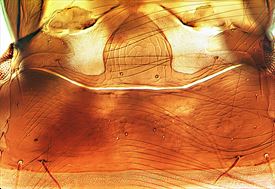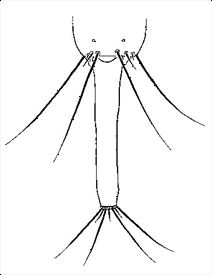Distinguishing features
Both sexes fully winged. Female dark brown, darkest on head and tube; fore tarsi, apices of fore tibiae, and major setae pale brown; terminal setae on tube darker; wings brown, pale at apex. Head longer than wide, shorter than tube, with 2 small projections on postenor margin; dorsal surface finely sculptured; ocelli well developed; compound eyes slightly smaller ventrally than dorsally; postocular setae long, fine, arising posteromesad of compound eyes, behind posterior ocelli; 1 pair of postocellar setae; 1 pair of curved preocellar setae longer than one side of ocellar triangle. Antennae 7-segmented; segments III and IV each with 2 sense cones, VI with a distinct pedicel. Pronotum finely sculptured; setae pointed, variable in length, but posterior pairs longer than anterior pairs; prosternal basantra absent; mesopresternum broadly boat-shaped. Mesonotum broad; metanotum elongate, finely reticulate. Fore tarsal tooth bluntly pointed. Fore wings parallel-sided, with 3 major sub-basal setae, S3 the longest, and 30–33 duplicated wing cilia. Pelta with anterior margin of median lobe rounded, lateral lobes slender, transversely elongate; tergite II eroded laterally, without posteroangular setae, strongly sculptured in median area; tergites II–VII each with 1 pair of sigmoid wing-retaining setae; tergite IX posteromarginal setae finely pointed, slightly shorter than tube; tube exceptionally long, constricted at apex.
Male similar to female but fore femora swollen; fore tarsal tooth large; major pronotal setae very long and fine, except anteromarginals.
Related species
Eight species are listed in this genus, of which five are from New Zealand, two from South Africa and one from Saudi Arabia. H. tillyardi is closely related to the type-species of the genus, H. tonnoiri, but has the tube distinctly longer and the fore wings differently coloured. Both of these species are interesting in that no changes in body form accompany the considerable individual size variation.
Biological data
Feeding on fungal spores, this species has been collected from dead branches and hollow stems.
Distribution data
Known only from New Zealand (BP, TO / SD, NN, BR, SC, CO / Chatham Is).
Family name
PHLAEOTHRIPIDAE, IDOLOTHRIPINAE
Species name
Heptathrips tillyardi Mound & Walker
Original name and synonyms
Heptathrips tillyardi Mound & Walker, 1986: 27
References
Mound LA & Palmer JM (1983) The generic and tribal classification of spore-feeding Thysanoptera (Phlaeothripidae: Idolothripinae). Bulletin of the British Museum (Natural History). Entomology 46: 1–174.
Mound LA & Walker AK (1986) Tubulifera (Insecta: Thysanoptera). Fauna of New Zealand 10: 1–140.




